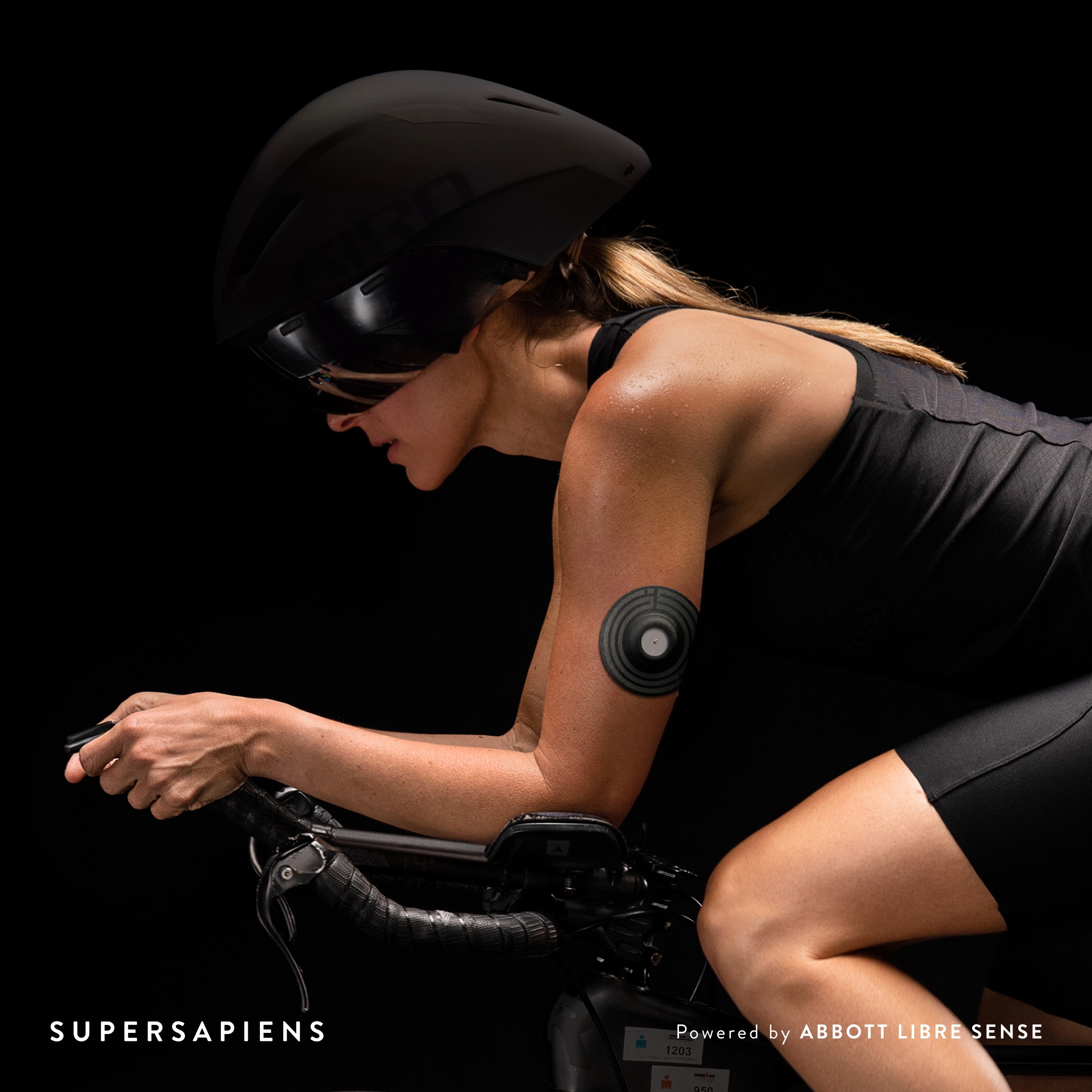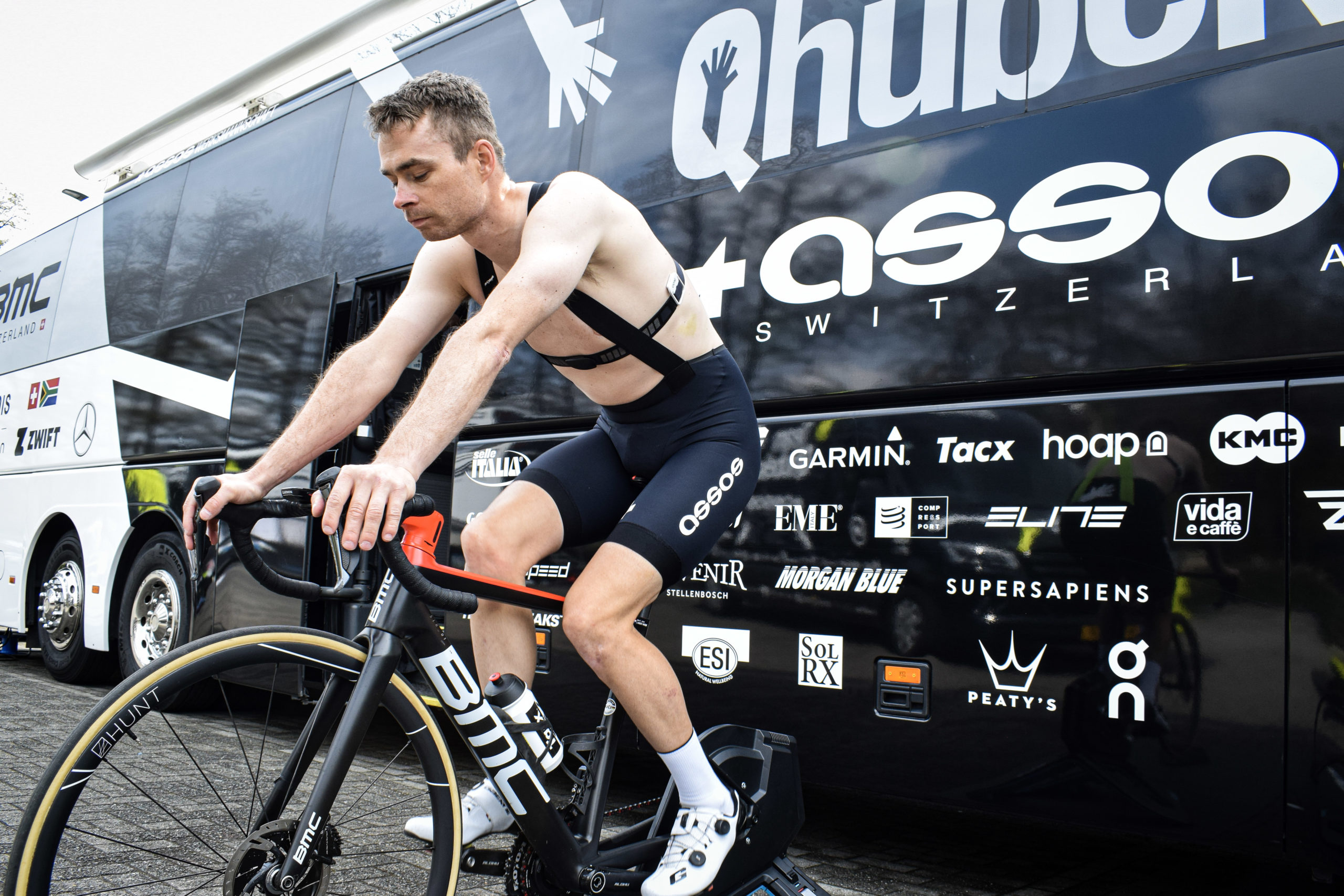Would you be interested in knowing how wearable tech could precisely tell your time to exhaustion if chasing down or breaking from a breakaway?
Or avoiding the kind of overheating that commonly trips up training programmes or provokes race day DNFs?
Or knowing for sure your bonk is in fact a physiological glucose deficit, and not a more psychological shenanigan?
A new breed of wearable tech is promising these kinds of insights and finding favour in the pro peloton.
Beyond heart rate monitors
For half a century body monitoring wearable tech in sports has been all about one innovation: the heart rate monitor.
Finnish firm Polar in 1977 introduced a wireless HRM that revolutionised and popularised live-tracking of a key physiological biomarker: heart beats per minute. It had been done before, but only in labs with bulky, wiry machines. Polar’s wireless wearable strapped a really useful data gathering contraption onto the sternum of anyone interested in improving and optimising their performance. Sports science took a giant leap in 1977.
Until the advent of the power meter in the late 1980s, heart rate was the key metric for live-monitoring endurance sports performance.
These metrics remain vital statistics few competitive cyclists, runners or triathletes would go without (hands up who doesn’t own a power meter?) but there are some new kids on the wearable tech bloc and interest in them is ratcheting up fast among pro teams and athletes and into the amateur ranks.
Could blood glucose, core body temperature and blood O2 monitors become indispensable fields on your chosen GPS unit? Just this week the near-standard Garmin-backed ANT+ ultra-low power (ULP) wireless protocol that allows devices like GPSs and sensors to speak to each other, added ‘core temperature’ as a beta profile field for developers to work with, so it may not be long before it officially joins other ANT+ device profiles like ‘power’ and the lesser known ‘muscle oxygen’.
Supersapiens – glucose training

Supersapiens employs the same Abbott Labs Libre blood glucose monitoring tech used by diabetics and applies it to sports with live glucose-based updates that can be synched with a Garmin smartwatch or the Supersapiens app. So athletes get a live glucose reading plus a historical data set to explore.
Atlanta-based CEO and founder Phil Southerland, himself a diabetic and ex-pro cyclist who co-founded the all-diabetes Team Novo Nordisk cycling team, says under-fuelling is a massive problem among all kinds of athletes – even among the pros where Supersapiens is making rapid inroads with partnerships with the likes of INEOS Grenadiers, Qhubeka, Jumbo-Visma, the CANYON//SRAM women’s team, BMC Pro Triathlon Team and being an official Ironman supplier.
“The data we’re seeing shows something like 45-55% of athletes who exercise for more than an hour are under-fuelled. About 5% are hypoglycaemic. An under-fuelled athlete is an athlete that is not achieving their maximum potential,” Southerland tells The Draft.
Southerland reckons human bodies can be trained to improve their glucose processing with the aid of tools like Supersapiens.
“One’s ability to get the glucose into the bloodstream and utilise it – is that a genetic gift or can it be trained? Take Ronan McLaughlin who recently set the Everesting record – our science team had the privilege of working with him in the weeks leading up to the event and he found with the help of Supersapiens that he could take in 150 grams of carbs per hour with a mix of solid foods, gels and drink mixes.”
An elite athlete’s gut can typically process about 60-90g/hour; a well-trained amateur athlete around 50-60g/hour.
“Thing is during exercise everyone is diabetic but you can do a lot more to control your glucose. Blood glucose is the newest metric in sport and arguably the most important.”
The UCI is however not on-side, citing a lack of glucose-related performance data and its insistence that racing should not be overly numbers-oriented, in refusing to allow blood glucose use in UCI-sanctioned races.
“It’s a shame because we know it works – we are approved by WADA, for mountain biking, Ironman, Formula 1 but not cycling – it’s sad. INEOS and Jumbo were prepared to conduct a scientific study at the Tour de France in 2020 but the UCI shut it down. But it’s not banned in amateur races. We haven’t given up – we are in ongoing discussion with the UCI.”
Qhubeka Assos: finding your fuelling A-game

Southerland references Qhubeka Assos – a smaller World Tour team that has excelled at this year’s Giro d’Italia with three stage wins, two of which featured riders who utilised Supersapiens in preparing for the three-week grand tour around the Italian boot.
“The owner of the team told me they had always been bad at fuelling so I think we played s small role in helping these guys figure out their fuelling game so they could come out swinging like they have,” Southerland enthuses.
Supersapiens are also researching gender-based differences in glucose response, including how it is influenced by the menstrual cycle.
Southerland says Supersapiens can function as an anti-bonking device, an elevated blood glucose reading may buoy riders whose perceived emptiness may be more mental than physical.
“There is also a safety feature, in that it can alert riders who are in danger of going hypoglycaemic.”
He said the company was learning much from the data set it is building. “We are working internally with data from key athletes as well as an anonymized data set from all users. We are fully GDPR compliant and do not sell user data.”
A monthly Supersapiens subscription costs about £130/month which includes two attach-to-the-tricep sensors, the app and other accessories.
CORE: taking the temperature of the peloton
Swiss-based CORE is built on a live-tracked body temp sensor that can clip onto a heart rate monitor strap and is similarly winning favour in the pro peloton.
CORE supplies World Tour outfits including Deceuninck-Quick-Step, Astana-PremierTech and Bora-Hansgrohe, Qhubeka Assos and Ceratizit-Wnt women’s team and triathletes like Alistair Brownlee use CORE. CORE is also collaborating with several athletes from the Norwegian Triathlon Team, including Kristian Blummenfelt and Lotte Miller.
One of the fundamental issues CORE addresses is the relatively poor perception humans have of our own core temperature. Many athletes are overheating well before they are aware of the fact, a situation that can compromise both performance and safety.
“One of the surprises is also how hot athletes can get – 39ºC is fever temperature but also fairly normal for athletes in high intensity over time,” says CORE comms manager Christopher Jones.
A study from the 2016 World Championships in the stonking hot Doha desert found 25% of tested riders registered core temps above 40.5ºC. “Some riders recorded 41.5ºC which is insane.” Average body temp is 36.9ºC.
Tackling heat stress
Jones told us the tech was peeling back crucial thermoregulation differences between riders in different conditions to better manage ‘heat stress’.
“In the public eye, heat stress is the most obvious application and this is relevant for teams although they will be gathering data on individual riders, understanding where ’they are at’ and then using the data for training and active cooling,” Jones relays.
This includes identifying which cooling strategies work best for a rider in areas like hydration, “even drink temperature or when a rider should splash or take off layers.”
“In team cycling the recon would mean understanding the typography and instead of taking off a jacket at the foot of the climb, take it off 10 or 20 minutes before to drop the core body temperature. In comparison the body is then cooler and there is more power available.”
2021 Giro d’Italia Stage 14
Analysis and rider core body temperature data.—
Monte Zoncolan is brutal and with 4ºC (39.2ºF) at the snowy finish, this @AstanaPremTech rider peaked with a core body temperature of 39.5ºC (103.1ºF) during the iconic ascent showing how hard it was!
— CORE | Core Body Temperature Monitoring (@corebodytemp) May 22, 2021
The tech is also aiding kit developers determine which fabrics and designs have the greatest cooling properties.
A CORE kit costs £230 and is compatible with Garmin and Wahoo and training apps like Today’s Plan, TrainingPeaks and Golden Cheetah.
Moxy: The physiological power meter
US-based Moxy measures and live tracks blood oxygen and haemoglobin levels and has been described as a ‘physiology-based power meter’.
Moxy has been on-market for about eight years and is used across endurance sports like cycling but also power sports like American football or weight lifting, where, as founder Roger Schmitz says, “There has never been a good metric to measure power output because a heart rate monitor gives a too-delayed response.”
In endurance sports the Moxy is allowing athletes to see their blood oxygen and haemoglobin levels in real time and Schmitz says making redundant some traditional lab-based tests like lactate threshold.
“What the Moxy does is take more substantial and evasive equipment and make it very small and portable and wearable and get it in real time on your Garmin or Wahoo,” Schmitz says. “It’s priced around the cost of a low-end power meter.”
Still the Moxy has remained relatively niche over the years, perhaps a function of its cost – about €650 – and what Schmitz observes as a slow appreciation of its benefits.
He points to a recent study that highlights how a Moxy in conjunction with a power meter has drilled down into the limits of sustainable power thresholds.
“The Moxy is allowing athletes to very precisely identify when they are above or below your threshold power. It can even accurately predict time to exhaustion which is a pretty useful metric in cycling. It takes time to learn how to use the tech to make athletes go faster.
Schmitz said a Kickstarter campaign was underway for a cloud-based app that would provide a proprietary analysis tool and was set for launch in October.
Jumbo glucose visibility excitement
Team Jumbo-Visma’s performance nutritionist Martijn Redegeld says the Dutch team is using Supersapiens to track rider glucose response to training, nutrition, stress and sleep.
“One of the main ways we’ve started to utilize the Supersapiens ecosystem is by optimizing the timing we start out training after breakfast,” Redegeld says. “Before, riders just jumped on their bikes at the set time on the daily schedule. Now we adjust the start to when glucose levels are in the ideal performance range following breakfast.”
“Another way we are learning from the Supersapiens ecosystem is in overnight recovery. We’ve noticed some remarkable differences in glucose response the night after an easy day compared to the night after a hard day of training or racing. We are still learning but believe this data will augment our current recovery strategies.”
“What excites me about glucose visibility is that it could be the next step in Team Jumbo-Visma’s personalized approach to nutrition throughout the day from fuelling while riding through recovery and beyond.”